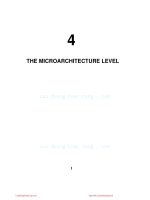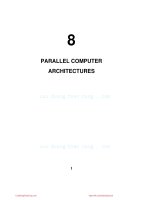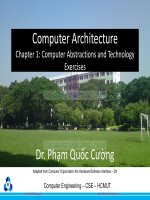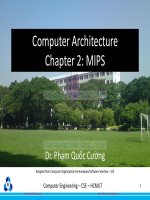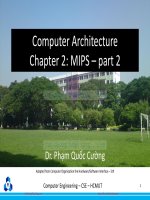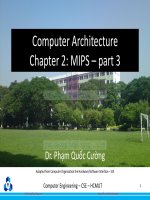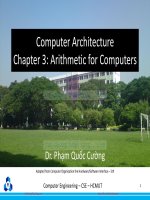kiến trúc máy tính trương văn cường quiz for chương ter 2 sinhvienzone com
Bạn đang xem bản rút gọn của tài liệu. Xem và tải ngay bản đầy đủ của tài liệu tại đây (64.35 KB, 12 trang )
Date:
Quiz for Chapter 2 Instructions: Language of the Computer
3.10
Not all questions are of equal difficulty. Please review the entire quiz first and then
budget your time carefully.
Name:
Course:
1. [5 points] Prior to the early 1980s, machines were built with more and more complex instruction
set. The MIPS is a RISC machine. Why has there been a move to RISC machines away from complex
instruction machines?
CuuDuongThanCong.com
/>
Name: _____________________
2. [5 points] Write the following sequence of code into MIPS assembler:
x = x + y + z - q;
Assume that x, y, z, q are stored in registers $s1-$s4.
Quiz for Chapter 2 Instructions: Language of the Computer
Page 2 of 12
CuuDuongThanCong.com
/>
Name: _____________________
3. [10 points] In MIPS assembly, write an assembly language version of the following C code segment:
int A[100], B[100];
for (i=1; i < 100; i++) {
A[i] = A[i-1] + B[i];
}
At the beginning of this code segment, the only values in registers are the base address of arrays A and B
in registers $a0 and $a1. Avoid the use of multiplication instructions–they are unnecessary.
Quiz for Chapter 2 Instructions: Language of the Computer
Page 3 of 12
CuuDuongThanCong.com
/>
Name: _____________________
4. [6 points] Some machines have a special flag register which contains status bits. These bits often
include the carry and overflow bits. Describe the difference between the functionality of these two bits
and give an example of an arithmetic operation that would lead to them being set to different values.
Quiz for Chapter 2 Instructions: Language of the Computer
Page 4 of 12
CuuDuongThanCong.com
/>
Name: _____________________
5. [6 points] The MIPS instruction set includes several shift instructions. They include logical-shiftleft, logical-shift-right, and arithmetic-shift-right. Other architectures only provide an arithmeticshift-right instruction.
a) Why doesn’t MIPS offer an “arithmetic-shift-left” opcode?
b) How would you implement in the assembler a logical-shift-left (LSL) pseudo-operation for a
machine that didn’t have this particular instruction? Be sure your LSL instruction can shift up to Wbits where W is the machine word size in bits.
Quiz for Chapter 2 Instructions: Language of the Computer
Page 5 of 12
CuuDuongThanCong.com
/>
Name: _____________________
6. [6 points] Consider the following assembly code for parts 1 and 2.
r1 = 99
Loop:
r1 = r1 – 1
branch r1 > 0, Loop
halt
(a) During the execution of the above code, how many dynamic instructions are executed?
(b) Assuming a standard unicycle machine running at 100 KHz, how long will the above code take to
complete?
Quiz for Chapter 2 Instructions: Language of the Computer
Page 6 of 12
CuuDuongThanCong.com
/>
Name: _____________________
7. [15 points] Convert the C function below to MIPS assembly language. Make sure that your
assembly language code could be called from a standard C program (that is to say, make sure you
follow the MIPS calling conventions).
unsigned int sum(unsigned int n)
{
if (n == 0) return 0;
else return n + sum(n-1);
}
This machine has no delay slots. The stack grows downward (toward lower memory addresses). The
following registers are used in the calling convention:
Register Name
Register Number
Usage
$zero
$at
$v0, $v1
$a0 - $a3
$t0 - $t7
$s0 - $s7
$t8, $t9
$k0, $k1
$gp
$sp
$fp
$ra
0
1
2, 3
4–7
8 – 15
16 – 23
24, 25
26, 27
28
29
30
31
Constant 0
Reserved for assembler
Function return values
Function argument values
Temporary (caller saved)
Temporary (callee saved)
Temporary (caller saved)
Reserved for OS Kernel
Pointer to Global Area
Stack Pointer
Frame Pointer
Return Address
Quiz for Chapter 2 Instructions: Language of the Computer
Page 7 of 12
CuuDuongThanCong.com
/>
Name: _____________________
8. [5 points] In the snippet of MIPS assembler code below, how many times is instruction memory
accessed? How many times is data memory accessed? (Count only accesses to memory, not registers.)
lw $v1, 0($a0)
addi $v0, $v0, 1
sw $v1, 0($a1)
addi $a0, $a0, 1
Quiz for Chapter 2 Instructions: Language of the Computer
Page 8 of 12
CuuDuongThanCong.com
/>
Name: _____________________
9. [6 points] Use the register and memory values in the table below for the next questions. Assume a
32-bit machine. Assume each of the following questions starts from the table values; that is, DO NOT
use value changes from one question as propagating into future parts of the question.
Register
Value
Memory Location
Value
R1
R2
R3
R4
12
16
20
24
12
16
20
24
16
20
24
28
a) Give the values of R1, R2, and R3 after this instruction: add R3, R2, R1
b) What values will be in R1 and R3 after this instruction is executed: load R3, 12(R1)
c) What values will be in the registers after this instruction is executed: addi R2, R3, #16
Quiz for Chapter 2 Instructions: Language of the Computer
Page 9 of 12
CuuDuongThanCong.com
/>
Name: _____________________
10. [20 points] Loop Unrolling and Fibonacci: Consider the following pseudo-C code to compute the
fifth Fibonacci number (F(5)).
1
2
3
4
5
6
7
8
int a,b,i,t;
a=b=1; /* Set a and b to F(2) and F(1) respectively */
for(i=0;i<2;i++)
{
t=a; /* save F(n-1) to a temporary location */
a+=b; /* F(n) = F(n-1) + F(n-2) */
b=t; /* set b to F(n-1) */
}
One observation that a compiler might make is that the loop construction is somewhat unnecessary.
Since the the range of the loop indices is fixed, one can unroll the loop by simply writing three
iterations of the loop one after the other without the intervening increment/comparison on i. For
example, the above could be written as:
1
2
3
4
5
6
7
8
int a,b,t;
a=b=1;
t=a;
a+=b;
b=t;
t=a;
a+=b;
b=t;
(a) Convert the pseudo-C code for both of the snippets above into reasonably efficient MIPS code.
Represent each variable of the pseudo-C program with a register. Try to follow the pseudo-C code as
closely as possible (i.e. the first snippet should have a loop in it, while the second should not).
(b) Now suppose that instead of the fifth Fibonacci number we decided to compute the 20th. How
many static instructions would there be in the first version and how many would there be in the
unrolled version? What about dynamic instructions? You do not need to write out the assembly for
this part.
Quiz for Chapter 2 Instructions: Language of the Computer
Page 10 of 12
CuuDuongThanCong.com
/>
Name: _____________________
11. [10 points] In MIPS assembly, write an assembly language version of the following C code
segment:
for (i = 0; i < 98; i ++) {
C[i] = A[i + 1] - A[i] * B[i + 2]
}
Arrays A, B and C start at memory location A000hex, B000hex and C000hex respectively. Try to reduce
the total number of instructions and the number of expensive instructions such as multiplies.
Quiz for Chapter 2 Instructions: Language of the Computer
Page 11 of 12
CuuDuongThanCong.com
/>
Name: _____________________
12. [6 points] Suppose that a new MIPS instruction, called bcp, was designed to copy a block of words
from one address to another. Assume that this instruction requires that the starting address of the
source block be in register $t1 and that the destination address be in $t2. The instruction also requires
that the number of words to copy be in $t3 (which is > 0). Furthermore, assume that the values of
these registers as well as register $t4 can be destroyed in executing this instruction (so that the registers
can be used as temporaries to execute the instruction).
Do the following: Write the MIPS assembly code to implement a block copy without this instruction.
Write the MIPS assembly code to implement a block copy with this instruction. Estimate the total
cycles necessary for each realization to copy 100-words on the multicycle machine.
Quiz for Chapter 2 Instructions: Language of the Computer
Page 12 of 12
CuuDuongThanCong.com
/>
